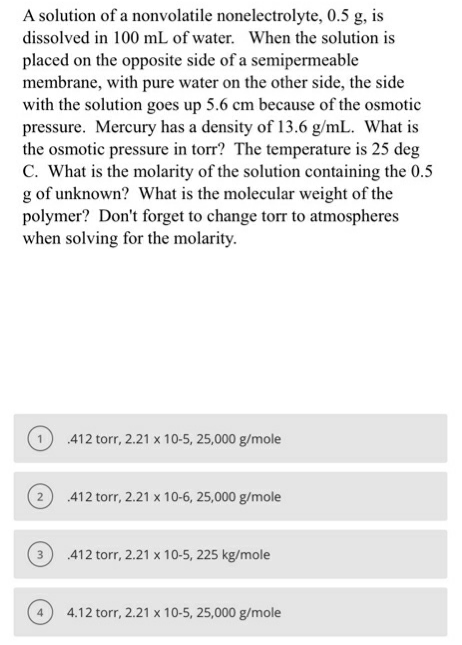A solution of a nonvolatile nonelectrolyte, 0.5 g, is dissolved in 100 mL of water. When the solution is placed on the opposite side of a semipermeable membrane, with pure water on the other side, the side with the solution goes up 5.6 cm because of the osmotic pressure. Mercury has a density of 13.6 g/mL. What is the osmotic pressure in torr? The temperature is 25 deg C. What is the molarity of the solution containing the 0.5 g of unknown? What is the molecular weight of the polymer? Don't forget to change torr to atmospheres when solving for the molarity.
A solution of a nonvolatile nonelectrolyte, 0.5 g, is dissolved in 100 mL of water. When the solution is placed on the opposite side of a semipermeable membrane, with pure water on the other side, the side with the solution goes up 5.6 cm because of the osmotic pressure. Mercury has a density of 13.6 g/mL. What is the osmotic pressure in torr? The temperature is 25 deg C. What is the molarity of the solution containing the 0.5 g of unknown? What is the molecular weight of the polymer? Don't forget to change torr to atmospheres when solving for the molarity.
Chemistry: Principles and Reactions
8th Edition
ISBN:9781305079373
Author:William L. Masterton, Cecile N. Hurley
Publisher:William L. Masterton, Cecile N. Hurley
Chapter10: Solutions
Section: Chapter Questions
Problem 68QAP: Consider two solutions at a certain temperature. Solution X has a nonelectrolyte as a solute and an...
Related questions
Question
100%

Transcribed Image Text:A solution of a nonvolatile nonelectrolyte, 0.5 g, is
dissolved in 100 mL of water. When the solution is
placed on the opposite side of a semipermeable
membrane, with pure water on the other side, the side
with the solution goes up 5.6 cm because of the osmotic
pressure. Mercury has a density of 13.6 g/mL. What is
the osmotic pressure in torr? The temperature is 25 deg
C. What is the molarity of the solution containing the 0.5
g of unknown? What is the molecular weight of the
polymer? Don't forget to change torr to atmospheres
when solving for the molarity.
Expert Solution
This question has been solved!
Explore an expertly crafted, step-by-step solution for a thorough understanding of key concepts.
This is a popular solution!
Trending now
This is a popular solution!
Step by step
Solved in 2 steps with 2 images

Knowledge Booster
Learn more about
Need a deep-dive on the concept behind this application? Look no further. Learn more about this topic, chemistry and related others by exploring similar questions and additional content below.Recommended textbooks for you

Chemistry: Principles and Reactions
Chemistry
ISBN:
9781305079373
Author:
William L. Masterton, Cecile N. Hurley
Publisher:
Cengage Learning

Chemistry & Chemical Reactivity
Chemistry
ISBN:
9781133949640
Author:
John C. Kotz, Paul M. Treichel, John Townsend, David Treichel
Publisher:
Cengage Learning

Chemistry & Chemical Reactivity
Chemistry
ISBN:
9781337399074
Author:
John C. Kotz, Paul M. Treichel, John Townsend, David Treichel
Publisher:
Cengage Learning

Chemistry: Principles and Reactions
Chemistry
ISBN:
9781305079373
Author:
William L. Masterton, Cecile N. Hurley
Publisher:
Cengage Learning

Chemistry & Chemical Reactivity
Chemistry
ISBN:
9781133949640
Author:
John C. Kotz, Paul M. Treichel, John Townsend, David Treichel
Publisher:
Cengage Learning

Chemistry & Chemical Reactivity
Chemistry
ISBN:
9781337399074
Author:
John C. Kotz, Paul M. Treichel, John Townsend, David Treichel
Publisher:
Cengage Learning

Chemistry: Principles and Practice
Chemistry
ISBN:
9780534420123
Author:
Daniel L. Reger, Scott R. Goode, David W. Ball, Edward Mercer
Publisher:
Cengage Learning

Principles of Modern Chemistry
Chemistry
ISBN:
9781305079113
Author:
David W. Oxtoby, H. Pat Gillis, Laurie J. Butler
Publisher:
Cengage Learning

Chemistry: The Molecular Science
Chemistry
ISBN:
9781285199047
Author:
John W. Moore, Conrad L. Stanitski
Publisher:
Cengage Learning